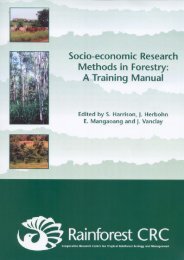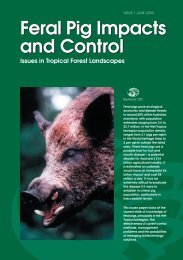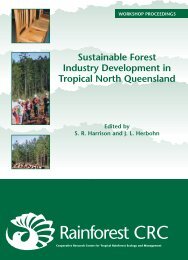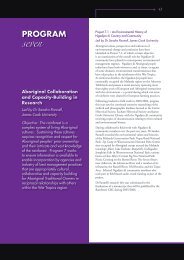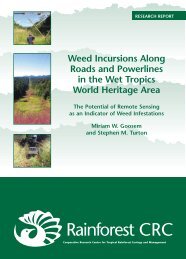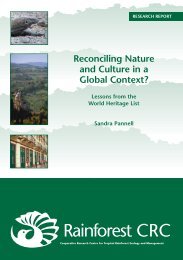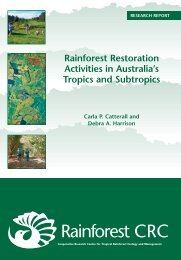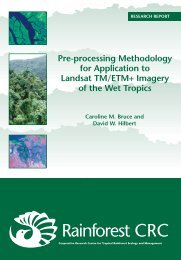Reconciling Nature and Culture in a Global Context? - Rainforest ...
Reconciling Nature and Culture in a Global Context? - Rainforest ...
Reconciling Nature and Culture in a Global Context? - Rainforest ...
Create successful ePaper yourself
Turn your PDF publications into a flip-book with our unique Google optimized e-Paper software.
<strong>Reconcil<strong>in</strong>g</strong> <strong>Nature</strong> <strong>and</strong> <strong>Culture</strong> <strong>in</strong> a <strong>Global</strong> <strong>Context</strong>?Lessons from the World Heritage Listtaxa. Emphasis upon nature’s ‘balance’ <strong>in</strong> evolutionary terms underscores criterion (i) <strong>and</strong>(ii) of the Convention’s Guidel<strong>in</strong>es <strong>and</strong> also the scientific response to them conta<strong>in</strong>ed <strong>in</strong> theAustralian Government’s nom<strong>in</strong>ation document. As a vast natural expanse of evolutionaryresidues (Figure 1), the ra<strong>in</strong>forests of North Queensl<strong>and</strong> are ak<strong>in</strong> to the monumentall<strong>and</strong>scapes of an ancient past, represented by Angkor, the Historic Centre of Rome, <strong>and</strong> anumber of other World Heritage cultural properties.Critical to the idea of a balanced nature result<strong>in</strong>g from cont<strong>in</strong>uous evolutionary processes isthe concept of an ‘untouched nature’, where evidence of human <strong>in</strong>tervention is either ignoredor downplayed so as not to detract from the area’s prist<strong>in</strong>e ‘natural’ values. This last po<strong>in</strong>t isparticularly apparent <strong>in</strong> the way European occupation of the wet tropical ra<strong>in</strong>forests isbrushed aside <strong>in</strong> three paragraphs <strong>in</strong> the nom<strong>in</strong>ation document. European, as opposed toAborig<strong>in</strong>al occupation is obviously regarded as negatively impact<strong>in</strong>g upon the ‘natural values’<strong>and</strong> ‘balance’ of the region. Notwithst<strong>and</strong><strong>in</strong>g more than a hundred years of Europeansettlement <strong>and</strong> at least 40,000 years of Aborig<strong>in</strong>al occupation, there are numerous examples<strong>in</strong> the nom<strong>in</strong>ation document <strong>and</strong> <strong>in</strong> the support<strong>in</strong>g reports where the region’s tropical forestsare described as ‘prist<strong>in</strong>e’ or <strong>in</strong> ‘virg<strong>in</strong> condition’ (ibid: 15).The notion of nature conveyed <strong>in</strong> the DASETT report as ‘prist<strong>in</strong>e preserved parts’ harks backto Enlightenment ideas where “the ‘natural’ was the appearance of the non-human <strong>in</strong> thepresences of any animals, plants <strong>and</strong> l<strong>and</strong>scapes beyond human control” (Luke 1995: 11).As Luke observes, these “Edenic myths of exceptionalistic purity” (loc. cit.) also <strong>in</strong>formedearly conservation efforts, <strong>and</strong> are still apparent <strong>in</strong> contemporary environmental movements.Given the key role of conservation groups <strong>in</strong> ‘secur<strong>in</strong>g’ the Wet Tropics, with the resultantbattle l<strong>in</strong>es drawn around natural zones without a discernable human presence, it is not sosurpris<strong>in</strong>g that this particular view of nature is kept alive <strong>in</strong> the nom<strong>in</strong>ation document.J. Baird Callicott <strong>and</strong> others suggest that the comprehension of nature <strong>in</strong> terms of an ‘entityoriented’evolutionary ecology, <strong>in</strong> which humans are depicted as a “destructive force ofchange external to the biota” (Callicott et al. 1999: 24), constitutes a particular school ofconservation philosophy, namely, ‘compositionalism’. Accord<strong>in</strong>g to these authors, ‘biological<strong>in</strong>tegrity’ <strong>and</strong> ‘biological diversity’ are key normative concepts <strong>in</strong> the glossary ofcompositionalism, while ‘ecological restoration’ <strong>and</strong> the ‘preservation’ of biological diversityare critical conservation objectives associated with this school of thought (ibid: 25).While the view of nature presented <strong>in</strong> the Wet Tropics nom<strong>in</strong>ation document has much <strong>in</strong>common with the philosophy of compositionalism, the biodiversity-centric vision of nature,which now dom<strong>in</strong>ates environmental <strong>and</strong> scientific discourses is not readily apparent. Theview of nature presented <strong>in</strong> the document largely conforms to the prevalent construction ofnature before it was declared ‘dead’ <strong>in</strong> the late 1980s <strong>and</strong> early 1990s (McKibben 1989;Merchant 1990). Prior to the ‘death’ of nature, conservation efforts were directed towardsprotect<strong>in</strong>g “untouched <strong>and</strong> undisturbed expanses” (Luke 1995: 13), some of which haddubious ecological worth.In keep<strong>in</strong>g with the concept of nature as “acceptable appearances <strong>and</strong> preserved presences”(Luke 1995: 14), the nom<strong>in</strong>ation document provides a detailed <strong>in</strong>ventory of endemic species,accompanied by photographic evidence of the ‘reality’ of the nature so memorialised. Asthese lists suggest, ‘nature’ is commonly presented <strong>in</strong> the nom<strong>in</strong>ation document as a th<strong>in</strong>gthat “really exists out there <strong>in</strong> the world” (ibid: 12) <strong>and</strong> is thus a discernable <strong>and</strong> valid objectof scientific study. In other words, nature is seen as someth<strong>in</strong>g which is ‘found’ or‘discovered’, rather than someth<strong>in</strong>g “that itself requires explanation” (Castree <strong>and</strong> Braun1998: 17). In keep<strong>in</strong>g with this ‘entity-oriented’ stance, so-called ‘natural values’ areregarded as an <strong>in</strong>herent property or quality of the geographic features <strong>and</strong> speciesdescribed, rather than part of the beliefs <strong>and</strong> practices associated with a group or a society ata particular po<strong>in</strong>t <strong>in</strong> time. In many respects, how society views nature is <strong>in</strong> part a function ofhow society has affected nature. <strong>Nature</strong> <strong>and</strong> the cultural conceptions of nature develop7




